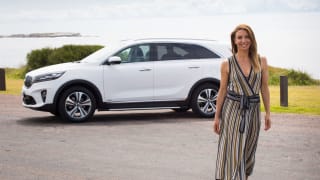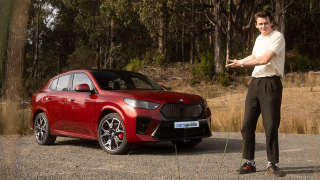Did you realise the Holden Acadia makes more power than any production Holden V8? The key phrase there is ‘Holden V8’ but it’s true, and a big feather in the cap for the Red Lion’s second biggest SUV of all time, next to the gargantuan Suburban of the late ‘90s.
It’s also a reminder that there’s still many ways to build a large seven-seat SUV, as pretty much every major car brand tries to outdo each other in their quest to build a big family machine with van-like practicality, car-like drive experience and looks that suggest you’re still an adventurer at heart.
Holden was a late starter in this field with the Acadia that launched just over a year ago, having relied on the previous Captiva 7 that soldiered on for more than a decade. The Captiva 7 never quite had the outright girth to keep up with the more recent Toyota Kluger, along with the likes of the Mazda CX-9, Hyundai Santa Fe and Kia Sportage that have become the great Australian dream for so many families.
The Holden is effectively a rebadged and right-hand drive version of the second-generation GMC Acadia that went on sale in North America a year and a half before it hit local showrooms, so it’s technically been around for about as long as the current CX-9 and Sorento.
In the context of my family, our LTZ will be lining up against the Santa Fe Elite, CX-9 Azami and Kia Carnival Platinum as the closest things in terms of outright space to grace my driveway, and each represent big shoes to fill in the literal and figurative senses.
It arrived with just 823km on the odometer, so we expect to be able to give you a good picture of the first 10,000 or so kilometres of ownership.

This is actually the first opportunity I’ve had to spend some quality time with the Acadia since I first drove it in prototype guise on Holden’s Lang Lang test track in late 2017, so look forward to discovering anything we haven’t revealed in our usual tests to date.
Why the LTZ over the base LT or top-spec LTZ-V? In a nutshell we wanted leather trim over the LT’s cloth for everyday family durability, and the LTZ-V’s extra fruit pushes its list price all the way up to $67,490 with all-wheel drive.
For the record, the LTZ-V extras include premium leather trim, additional adjustability for the driver’s seat with memory settings, ventilated front seats, dual panel sunroof, HID headlights, locally calibrated adaptive suspension, adaptive cruise control, 360 degree camera system, highway AEB, bigger 8.0-inch driver instrument display, Bose audio with amplifier and subwoofer, and bigger 20-inch wheels.
For $10,000 less, the LTZ’s highlights still include all the important safety gear, plus tri-zone climate control (giving us independent temperature control for passengers in the second and third rows), a wireless phone charger, heated front seats with independent controls for base and backrest, power tailgate with proximity control, traffic sign recognition with intelligent speed assist (alerts you when speed limits change), auto wipers and an auto parking function.
We opted for the $4000 optional all-wheel drive version because we’re hoping for the chance to put it through its paces, which pushes the price of our example up to $57,490 before on-road costs.
We also requested the optional tow bar to take advantage of the 2000kg braked rating and see how fuel consumption is affected when under load. Ours arrived without a towball fitted, so we’ll have to sort that before we put it to the test.

As expected, I fitted our two 0-4 baby seats without any dramas using the ISOFIX mounts in the two outboard positions of the second row of seats, but was impressed to see that both third row positions have top tether anchorage points. Top tether isn’t as sturdy as when combined with ISOFIX, but at least gives you the ability to fit up to five child seats aboard the Acadia.
The back doors also open to almost 90 degrees, which is great for when loading the child seats in the second row, and optimising the exit point when disembarking from the third row.

Given Australia is the only right-hand drive market with Acadia available (the rest are LHD), I was impressed to be reminded that the indicators have been set up on the right hand side of the steering wheel, and the centre console has been reoriented with the gear selector and shift indicator toward the right hand side. Plenty of other left-hand drive origin cars don’t go to this level of effort.

One area where the Acadia is yet to optimised for right-hand drive is the second row seat split-fold function, which still puts its 40 per cent portion on the right-hand side. This means it’s still easiest to give passengers access to the third row from the right side of the vehicle, which is hardly ideal when parallel parked on the street. The Acadia is not alone in this omission, with the Nissan Pathfinder being another notable perpetrator.
One other Acadia quirk is that it hides the steering wheel volume controls behind the steering wheel like in a Jeep, Peugeot or Citroen. This is fine once you know they’re there, but could be very dangerous for anyone who searches for them for the first time while driving.

Another steering wheel quirk is that you answer phone calls via the voice command button. You hang up via a conventionally labeled hang up button, but the answer button isn’t marked with anything that suggests it handles more than voice commands.
We’ve managed to cover just over 1100kg in our first weeks with the Acadia, covering a good mix of urban driving and motorway running between the Blue Mountains and Sydney city. This is therefore reflective of the driving conditions the Acadia AWD’s 12.9L/100km combined figure (94kg lighter 2WD is 12.5) aims to represent, and makes the 11.3L/100km test average we’ve recorded so far look mighty impressive.
We’ve only used the cheaper 91 RON unleaded, and the 1975kg Acadia is propelled by a big-capacity 3.6-litre petrol V6 that we first saw in a more basic form in the VZ Commodore in 2004. None of these things are conducive to good fuel economy, but you can’t argue with the test results so far.
The Acadia-spec 3.6 was also used in the recently-departed ZB Commodore, and helping it compete in 2020 is the same nine-speed auto, direct injection and stop/start system used by the European Commodore.
Back to the pub ammo I mentioned at the start, the Acadia’s 231kW is about 5kW more than what the legendary “XU-3 Yellah” VS GTS-R could produce from its 5.7-litre stroker V8, even with the optional HRT Optimised blueprint package. Its 367Nm is more than 100Nm short of the famous yellow-winged beast though.
We hope to bring you more ammo next month.
Acquired: January 2020
Distance travelled this month: 1,115km
Odometer: 1938km
Average fuel consumption for January: 11.3L/100km (measured at the pump)











